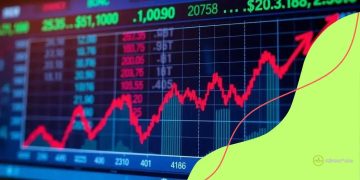Implications of the yield curve analysis for investors

The yield curve analysis is crucial for investors as it predicts economic conditions, informs investment strategies, and indicates potential interest rate changes that can significantly impact financial decisions.
The implications of the yield curve analysis are pivotal for investors looking to navigate financial markets. Have you ever wondered how this tool can influence your investment choices? Let’s find out together.
Understanding the yield curve’s structure
Understanding the yield curve’s structure is essential for investors. The yield curve is a graphical representation that shows the relationship between interest rates and different borrowing periods. By analyzing this curve, investors can predict future economic conditions.
The Basics of the Yield Curve
A typical yield curve shows how interest rates vary with time. Short-term rates are usually lower than long-term rates. This is because longer-term investments carry more risk. When the curve slopes upward, it indicates that investors expect stronger economic growth in the future.
Types of Yield Curves
There are three main types of yield curves:
- Normal yield curve: An upward slope indicates a healthy economy.
- Inverted yield curve: A downward slope could signal a recession.
- Flat yield curve: Suggests uncertainty in the economy.
Understanding these types can help investors make informed decisions based on market conditions. Investors should keep an eye on the slope of the yield curve, as changes can have significant implications.
Factors Influencing the Yield Curve
Several factors can affect the shape of the yield curve:
- Inflation: Higher expected inflation can lead to increased interest rates.
- Monetary policy: Central banks manage interest rates to control economic growth.
- Investor sentiment: Changes in investor confidence can shift the curve.
By studying these elements, investors can gain insights into future trends. The yield curve is not just a reflection of current rates; it also serves as a tool for forecasting economic activity.
How the yield curve impacts investment strategies
Understanding how the yield curve impacts investment strategies is crucial for making informed financial decisions. Investors can analyze the yield curve to predict economic trends and adjust their strategies accordingly. The yield curve informs investors about future interest rates and economic conditions, which can lead to more effective investment choices.
Investment Decisions Based on the Yield Curve
When the yield curve is steep, it often indicates that investors expect higher growth and inflation. In this case, long-term investments, such as stocks and real estate, may be more attractive. Conversely, when the curve flattens or inverts, it signals potential economic weakness. This situation might prompt investors to prioritize safer assets such as bonds.
Risk Management Strategies
Investors also use the yield curve to manage risk:
- Diversification: A well-balanced portfolio can shield against yield curve changes.
- Duration Matching: Adjusting bond durations can help mitigate interest rate risks.
- Hedging: Utilizing options and futures can protect against potential losses.
These strategies can help minimize risks associated with volatile yield curve shifts. Investors must stay informed about economic indicators that may affect the yield curve.
Asset Allocation Insights
The yield curve also informs asset allocation. Depending on the curve’s shape, investors may choose to adjust their holdings in stocks versus bonds. A bullish outlook might encourage investment in equities, while a bearish mood may prompt heavier bond purchases to safeguard capital. In addition, understanding how different sectors react to interest rate changes can guide sector rotation, enhancing overall portfolio performance.
Moreover, consistent monitoring of the yield curve enables investors to maintain a proactive approach. Keeping up with economic news and central bank policies can help investors adapt their strategies as the financial landscape evolves. Overall, the yield curve serves as a vital tool for tailoring investment tactics and navigating financial markets.
Interpreting yield curve shifts

Interpreting yield curve shifts is crucial for understanding economic trends and making informed investment decisions. A shift in the yield curve can reveal changes in investor sentiment, inflation expectations, and economic growth. Investors must learn how to read these shifts to adjust their strategies effectively.
The Significance of Yield Curve Shifts
When the yield curve shifts, it can signal various economic scenarios. For example, an upward shift typically suggests optimism about future growth. Conversely, a downward shift may hint at potential economic slowdowns. By paying close attention to these shifts, investors can gain insights into market movements and make timely decisions.
Types of Yield Curve Shifts
There are a few key types of yield curve shifts:
- Parallel shifts: All interest rates change by the same amount, indicating uniform changes in economic expectations.
- Steepening: Long-term rates rise faster than short-term rates. This often indicates increasing inflation expectations.
- Flattening: Short-term rates increase relative to long-term rates, signaling potential economic uncertainty or a slowdown.
A clear understanding of these shifts helps investors to position their portfolios accordingly. For instance, if a steepening occurs, investors may favor equities over bonds to capture growth.
Indicators of Yield Curve Shifts
Several factors can trigger shifts in the yield curve:
- Central bank policies: Changes in interest rates set by central banks can cause immediate yield curve adjustments.
- Economic data: Reports on inflation, employment, and GDP growth can influence investor expectations.
- Global events: Political or economic instability can lead to significant yield curve adjustments.
By monitoring these indicators, investors can anticipate how yield curve shifts may impact their strategies. Understanding the relationship between the curve and economic outlook allows investors to better navigate financial markets.
Real-world examples of yield curve implications
Exploring real-world examples of yield curve implications helps investors understand how shifts in the yield curve affect various financial decisions. Past experiences illustrate the importance of analyzing the yield curve in relation to economic scenarios.
Example 1: 2008 Financial Crisis
During the 2008 financial crisis, the yield curve inverted, indicating a recession was imminent. This inversion led to a great deal of uncertainty in financial markets. Analysts noted that the curve’s shape suggested that investors were expecting lower future growth. As a result, many shifted their investments to safer assets like government bonds, which offered more security during turbulent times.
Example 2: Economic Recovery Post-2008
Following the crisis, the yield curve began to steepen again in 2016 as the economy showed signs of recovery. This uptrend indicated that investors were becoming more optimistic about future growth. Stocks became more appealing, and many investors started reallocating their portfolios to include higher-risk investments, hoping to capitalize on the recovery.
Example 3: Pandemic Economic Impact in 2020
In early 2020, the COVID-19 pandemic caused significant shifts in the yield curve. Initially, the curve flattened as interest rates were cut in response to the economic downturn. Investors rushed to bonds, fearing a long-lasting recession. However, as vaccines became available and economic activity resumed, the yield curve steepened, suggesting recovery, which encouraged many to invest in equities once more.
Example 4: Current Trends and Future Implications
Monitoring current yield curve developments is essential for understanding upcoming market conditions. Recently, an increase in inflation expectations has caused the yield curve to steepen again. This trend suggests that investors anticipate rising interest rates. Many are adjusting their investments, preparing for potential changes in the economic landscape.
By studying these real-world examples, investors can see how the yield curve influences market behavior and shapes investment strategies over time. Such insights are invaluable for making informed decisions in today’s fast-paced financial environment.
Future trends in yield curve analysis
Future trends in yield curve analysis are vital for investors as they navigate an ever-changing economic landscape. Understanding how the yield curve may evolve can lead to better investment strategies and risk management. Analysts are increasingly focusing on several emerging factors that could influence yield curves in the years to come.
Impact of Technology and Data Analytics
The rise of technology and data analytics plays a significant role in yield curve analysis. Advanced algorithms allow investors to process vast amounts of data quickly. This enables them to make predictions about future interest rates and economic shifts based on real-time information. As data analytics becomes more sophisticated, the accuracy of yield curve assessments will likely improve.
Global Economic Influences
In today’s interconnected world, global economic events greatly affect yield curves. For instance, decisions made by central banks in major economies can ripple through markets worldwide. Investors must stay informed about international developments that could impact their local yield curves.
- Trade agreements: Changes in trade policies can influence economic growth and inflation.
- Political stability: Geopolitical tensions can lead to increased market volatility.
- Foreign investments: Shifts in capital flows can alter demand for domestic bonds.
Understanding these global influences is essential for accurate yield curve analysis and strategic positioning.
Inflation Expectations and Monetary Policy
As inflation becomes a greater concern, how central banks respond is crucial for yield curves. An increase in interest rates can flatten the yield curve. Conversely, if central banks favor a more accommodative stance, the curve may steepen. Monitoring inflation expectations will help investors adjust their strategies based on anticipated changes in monetary policy.
As economic conditions continue to shift, anticipating how these factors will interact with the yield curve becomes vital. Investors who adapt to these trends can better navigate uncertainty.
FAQ – Frequently Asked Questions about Yield Curve Analysis
What does a yield curve represent?
A yield curve shows the relationship between interest rates and different maturities of debt, indicating the cost of borrowing over time.
Why is the yield curve important for investors?
It helps investors predict future economic conditions, manage risks, and make informed investment decisions based on interest rate trends.
What can an inverted yield curve indicate?
An inverted yield curve often signals an upcoming recession, as it suggests that short-term interest rates are higher than long-term rates.
How can data analytics improve yield curve analysis?
Advanced data analytics allows for quicker processing of economic data, improving predictions about yield curve shifts and market responses.





